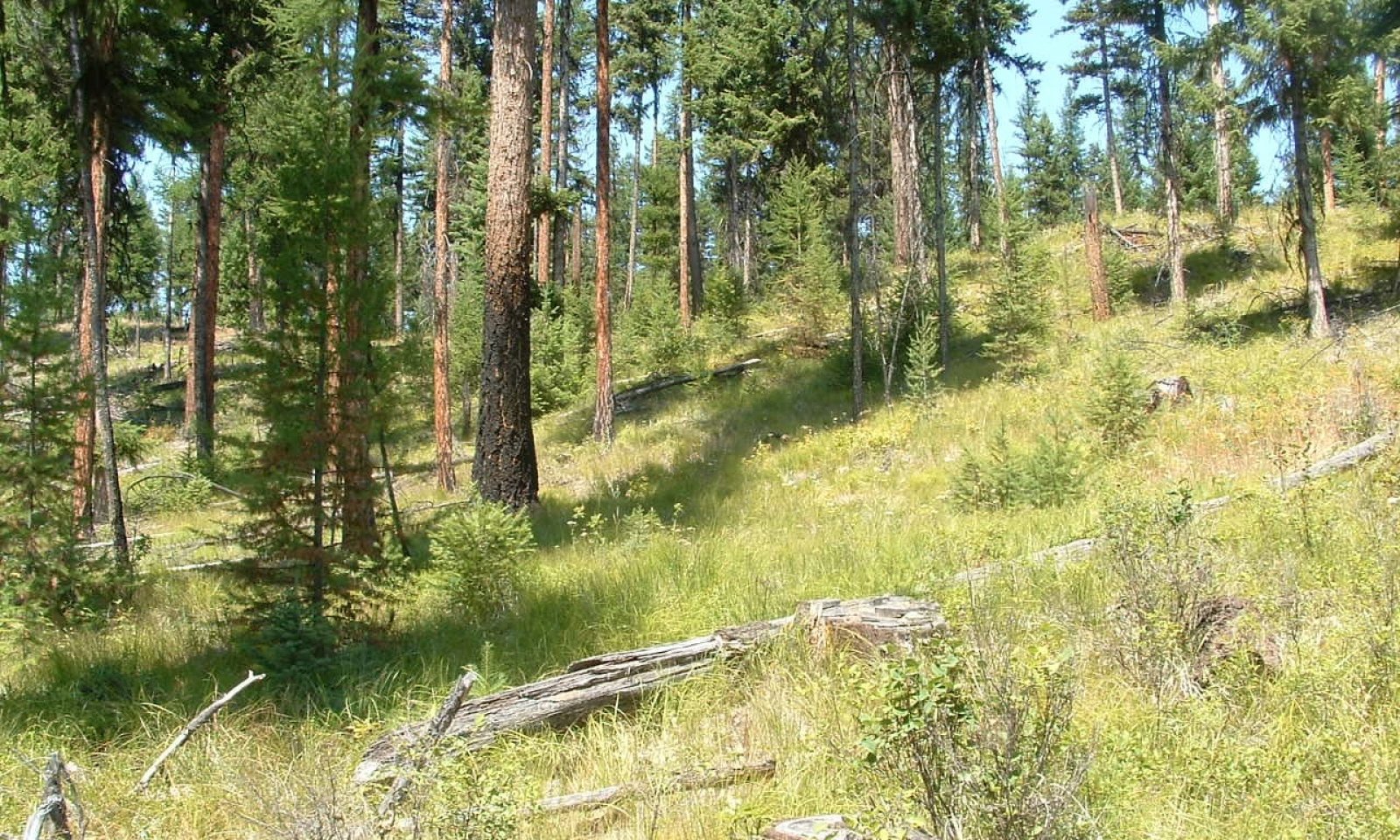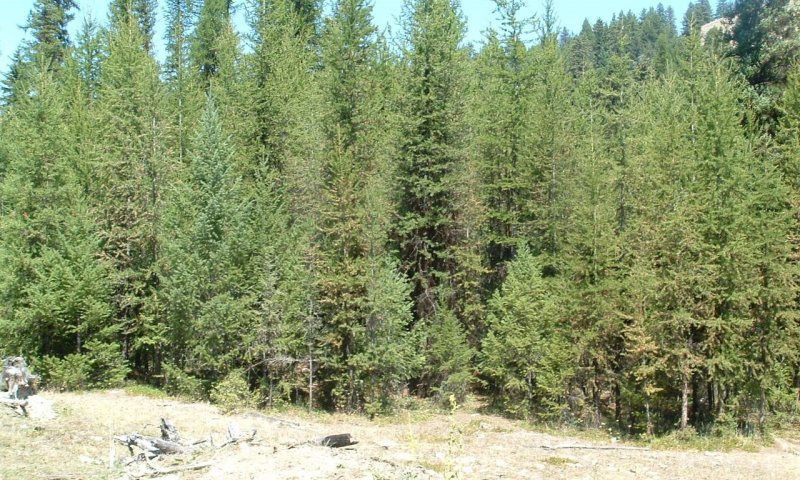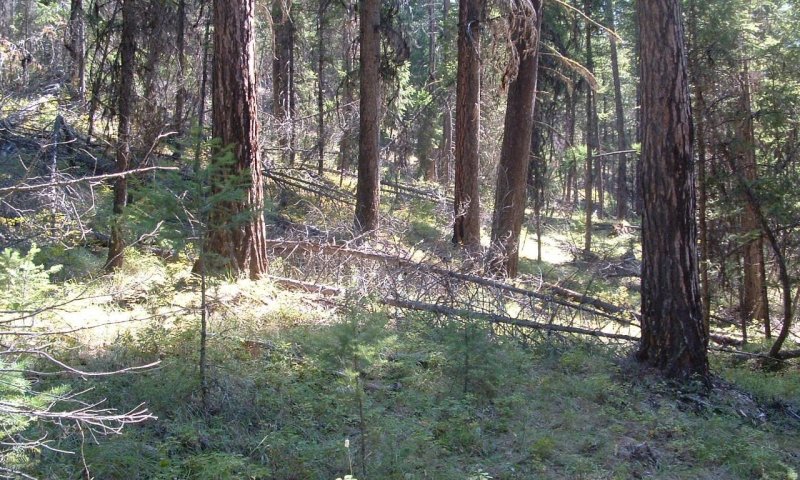
Ecological site group EX043AESG04
Cool-Frigid, Xeric, Hill and Mountain Slopes (Douglas Fir/Cool Dry Grass) Pseudotsuga menziesii - Calamagrostis rubescens
Last updated: 05/02/2025
Accessed: 12/15/2025
Ecological site group description
Key Characteristics
None specified
Provisional. A provisional ecological site description has undergone quality control and quality assurance review. It contains a working state and transition model and enough information to identify the ecological site.
Physiography
Major Land Resource Area: 43A Northern Rocky Mountain and Foothills
Modal LRU: 43A01 Okanogan Plateau
This LRU is composed predominantly of mid-elevation slopes of hills and mountains. It is found on the glaciated terrain west of the Republic Graben. The soils tend to be loamy mollisols, andisols and inceptisols with mixed to thick ash surfaces. Till, outwash and glacially scoured granitics are the dominant parent materials. Soil climate is a frigid or cryic temperature regime and xeric moisture regime with average annual precipitation around 470 mm (18 inches).
Others where occurring: 43A02 Western Selkirk Highlands
43A03 Columbia-Colville Valleys
Ecological Site Concept:
The data below describes the physiographic, climatic and other parameters for the Douglas-fir/cool grass ES group as a whole. This vegetation alliance is widespread so a central tendency for each parameter is also described.
This ESD is distinguished by an overstory of Douglas-fir, western larch, and ponderosa pine and an understory of pinegrass. It occurs on mountainsides, ridgetops, and cool air drainage level slopes. Frequent low intensity fire created park-like stands of large open stands of Douglas-fir, western larch, and ponderosa pine. Western larch will be more prominent in the cooler higher elevations and ponderosa pine in the warmer lower elevations. Pinegrass is the dominant herbaceous species and rapidly advances after disturbance. Fire suppression and management use have currently created dense stands of Douglas-fir underneath large Douglas-fir, larch, and pine. This site fits into the National Vegetation Standard’s Central Rocky Mt. Douglas-fir – Ponderosa pine Herbaceous Understory and the Washington State Natural Heritage Program’s Northern Rocky Mt. Dry Mesic Montane Mixed Conifer forest.
Physiographic Features
This ecological site occurs mainly on forested glaciated mountain back slopes, shoulders and foot slopes. It is found between 1,100 feet and 6,000 feet in elevation on all aspects. Slopes generally range from 15 to 40 percent, but can be found on slopes up to 90 percent.
Landscapes: Glaciated Mountains and Foothills
Landform: Mountain slopes, Hill slopes, Outwash terraces, Till plains
Elevation: Total range: 345-1845m
(1,130 to 6,050 feet)
Central tendency: 905-1280m
(2,970 to 4,200 feet)
Slope (percent): Total range: 0-80
Central tendency: 15-40 Water Table Depth: 58- >200 cm
(23 to >80 inches)
Flooding: Frequency: None
Duration: None
Ponding:
Depth (inches): 0
Frequency: none Duration: None
Aspect: 225-80-175 in 43A01
20-225-70 in 43A02
30-235-0 in 43A03
Climate
Climatic Features
During the spring and summer, a circulation of air around a high-pressure center brings a prevailing westerly and northwesterly flow of comparatively dry, cool and stable air into the region. As the air moves inland, it becomes warmer and drier which results in a dry season beginning in the late spring and reaching a peak in mid-summer. In the fall and winter, a circulation of air around two pressure centers over the ocean brings a prevailing southwesterly and westerly flow of air into the Pacific Northwest. This air from over the ocean is moist and near the temperature of the water. Condensation occurs as the air moves inland over the cooler land and rises along the windward slopes of the mountains or highlands. This results in a wet season beginning in October, reaching a peak in winter, then gradually decreasing in the spring.
The elevation within the LRU varies from approximately 1,000 feet in the lower river valleys to 3,500 feet over the Okanogan highlands. North-south ranges of mountains extending into southern British Columbia reach elevations of 4,000 to 5,000 feet within a few miles of the Okanogan River. The annual precipitation increases from 11 inches in the valley to 23 inches over some of the Plateau. Winter season snowfall varies from 30 to 70 inches. Both rainfall and snowfall increase in the higher elevations. Snow can be expected after the first of November and to remain on the ground from the first of December until March or April. The few snow survey reports available for elevation above 5,000 feet indicate six to eight feet of snow on the ground the first of April and four to five feet the first of May.
In January, the average maximum temperature is near 30° F and the minimum temperature is 15° F. Minimum temperatures from -10° to -20°F are recorded almost every winter and temperatures ranging from -25° to -42° F have been recorded in the colder valleys. In July, the average maximum temperature is 85° to 90° and the minimum temperature 45° to 50° F. Maximum temperatures reach 100° F on a few afternoons each summer and temperatures between 105° to 110° F have been recorded. Temperatures in the mountains decrease three to five degrees Fahrenheit with each 1,000 feet increase in elevation. The average date of the last freezing temperatures can be expected in the colder valleys by the first of September and before mid-October in the warmer areas. (From WRCC: Climate of Washington)
Mean Annual precipitation
Total Range: 276-840 mm
(11 to 33 inches)
Central tendency: 430-595 mm
(17 to 23 inches)
MAAT
Total Range 2.5-9.7 C
(36 to 49 F)
Central tendency: 5.2-7.0 C
(41 to 45 F)
Frost free period (days)
Total range: 75-135
Central tendency: 95-110
Soil features
Representative Soil Features
This ecological site group is associated with several soil components. The soil components can be grouped into four soil subgroups: Typic Vitrixerands, Vitrandic Haploxerepts, Vitrandic Haploxerolls, and Andic Haploxerepts. Soils in this ecologic site are very deep to moderately deep with available water holding capacities mostly equal to or greater than 6.7 cm (in 100cm). Most of these soils have developed in Mazama tephra deposits over till, outwash and residuum and colluvium from granitic and metamorphic rock. These tephra layers are important for forest productivity in that they retain large amounts of water compared to other parent materials, have high cation exchange capacity and high availability of organically bound plant nutrients. Minor amounts of soil are formed in lacustrine deposits. The soils are mostly well-drained. Surface textures include ashy fine sandy loam, ashy silt loam, stony and/or ashy loam.
Soil series occuring in this ESD:
Soil series with plant community Douglas-fir/pinegrass:
Bamber, Bernhill, Brevco, Centralpeak, Chumstick, Cobey, Coxit, Dearyton, Doe, Donavan, Eloika, Enson, Farway, Friedlander, Goddard, Goshawk, Growden, Hagen, Hardesty, Havillah, Jimbluff, Kenotrail, Kiehl, Koepke, Koepke, Koerling, Lekrem, Limking, Longort, Loony, Louploup, Martella, Merkel, Merkel, Midpeak, Molson, Nahahum, Nevine, Newhorn, Nicmar, Ohscow, Ontrail, Oxerine, Parmenter, Pebcreek, Pepoon, Pettijohn, Radercreek, Redpeak, Rendovy, Republic, Rockhill, Sacheen, Salcreek, Santop, Scrabblers, Shalrock, Stemilt, Stepstone, Thout, Thow, Torboy, Veridge, Vinegar, Vingulch, Wapal, Wellie, Wilma, Wolfeson, Yellcreek
Parent Materials:
Kind: Volcanic ash, Till, Outwash, Residuum and Colluvium
Origin: Granite, Gneiss, Andesite and Dacite
Surface Texture:
(1)Ashy Fine sandy loam (2)Ashy Silt loam (3)Ashy Loam Subsurface Texture Group: Loamy Surface Fragments
Vegetation dynamics
Ecological Dynamics of the Site
Open park-like stands of large diameter Douglas-fir, western larch and ponderosa pine with a pinegrass dominated understory. Frequent low severity ground fires every 10-20 years kept understory natural tree establishment low and maintained pinegrass cover. Overstory tree composition depends on seed source and moisture conditions. Douglas-fir and western larch dominate stand composition with low percentages of ponderosa pine depending on site disturbance. On the warmer portions of this site at lower elevations ponderosa pine will be dominate with scattered Douglas-fir and western larch. This site occurs on southern exposures or ridgetops at higher elevations (5,000-6,000 feet) and on flats or outwash plains with cool air drainage at lower elevations. Most of the soils are granitic or glacial till with a volcanic ash cap. Lodgepole pine can be present in overstory and understory depending on seed source and cool air drainage conditions and fire occurrence. Fire exclusion has cause natural regeneration to advance from seedling to high density pole stands underneath the larger older trees creating a severe fire hazard and increased potential for stand replacing fire capable of causing mortality to the older large diameter overstory. This site, along with the Douglas-fir Warm Dry Shrub (DFWDS) site, composes the largest acreage in MLRA 43A. It commonly occurs adjacent to the DFWDS site at the higher landscape position or gradients to DFWDS as the site gets warmer. Douglas-fir is susceptible to budworm and tussock moth defoliation during drought years. Dwarf mistletoe can be present in Douglas-fir and western larch.
Relationship to Other Established Classifications:
United States National Vegetation Classification (2008) - A3395 Douglas fir- P. Pine / Herbaceous Understory Central Rocky Mt. Forest & Woodland Alliance
Washington Natural Heritage Program. Ecosystems of Washington State, A Guide to Identification, Rocchio and Crawford, 2015 - Northern Rocky Mt. Dry-Mesic Montane Mixed Conifer Forest (D. Fir – Pine)
Description of Ecoregions of the United States, USFS PN # 1391, 1995 - M333 Northern Rocky Mt. Forest-Steppe-Coniferous Forest-Alpine Meadow Province
Level III and IV Ecoregions of WA, US EPA, June 2010 - 15x Okanogan Highland Dry Forest. 15w Western Selkirk Maritime Forest. 15r Okanogan – Colville Xeric Valleys & Foothills.
This ecological site includes the following USDA Forest Service Plant Associations: PSME/CARU (Douglas-fir Series). (Williams et. al. 1995)
Major Land Resource Area
MLRA 043A
Northern Rocky Mountains
Subclasses
- F043AY515WA–Cool-Frigid, Xeric, Loamy Mountainsides, low AWC subsoils (Douglas Fir/Cool Dry Grass) Pseudotsuga menziesii - Calamagrostis rubescens
- F043AY516WA–Cool-Frigid, Xeric, Sandy Outwash Terraces, mixed ash surface (Douglas-fir/Cool Dry Grass) Pseudotsuga menziesii - Calamagrostis rubescens
- F043AY513WA–Cool-Frigid, Xeric, Loamy Mountainsides, ashy surface (Douglas-Fir/Cool Dry Grass) Pseudotsuga menziesii - Calamagrostis rubescens
- F043AY514WA–Cool-Frigid, Xeric, Loamy Mountainsides, mixed ash surface (Douglas Fir/Cool Dry Grass) Pseudotsuga menziesii - Calamagrostis rubescens
Stage
Provisional
Click on box and path labels to scroll to the respective text.




